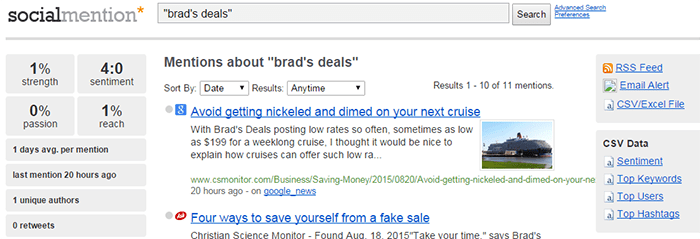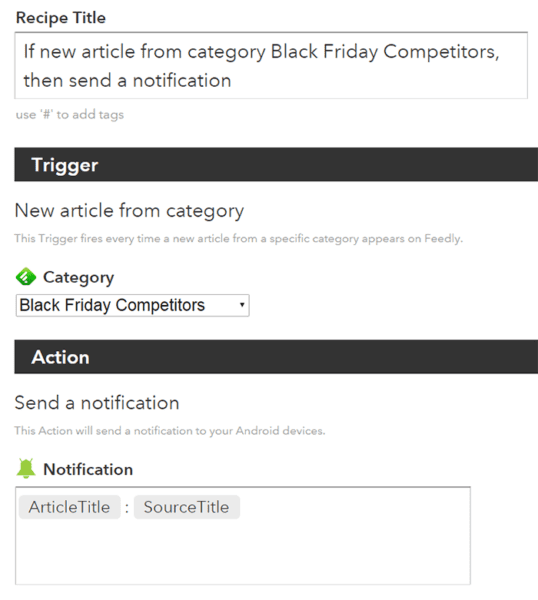
How to Build a Real-Time Listening Post for a Time-Sensitive Vertical
This YouMoz entry was submitted by one of our community members. The author’s views are entirely their own (excluding an unlikely case of hypnosis) and may not reflect the views of Moz.
When you’re working in a highly competitive, fast-moving niche, keeping up with the latest developments can be like trying to drink from a fire hose. Because of the volume and velocity, it’s necessary to be as streamlined as possible while diving deep into the material at the same time. Being able to react to the most important material as quickly as possible is critical.
As a white hat affiliate marketer operating at scale, I keep a close eye on more than a few topics. At Brad’s Deals, our most intense season in terms of the vigilance and responsiveness required is Black Friday, where our fans expect us to have the latest ads posted the moment they hit the Internet, and it’s rare that any merchant, even one we have a good partnership with, will think to send it our way.
Plus, these ads are so hotly sought after, that it’s not unusual to see them leak online ahead of their official publication, and that doesn't always happen during business hours. We have to be able to catch and take action on time-sensitive ads, leaks, and news as it happens 24 hours a day, 7 days a week, for six to eight weeks at a time. Streamlining and automating the monitoring process as much as possible is essential, both for the sake of efficiency and maintaining one's sanity.
Why digital listening?
The idea behind the digital listening concept is to pull articles, blog posts, news media, images, social media, and page updates that normally would be monitored in a number of different places into a single platform where everything can be watched simultaneously.
Additionally, the most critical information should trigger alerts so the team can react quickly outside of business hours without being chained 24/7 to a laptop.
How is all of this important to SEO?
Being the first to post content caters to Google’s taste for fresh material, especially if you can add fresh insight as you go. It also makes makes everything that comes after your article look like a copycat. The ability to react quickly to the latest news makes it more likely that you earn the click, you earn the share, you earn the citation, and you earn the link.
By the way, nearly everything I mention in here is free. Even the one paid tool I mention has a free alternative. (I have never found a paid tool that comes close to being as effective as the listening post I've built on my own using free tools.)
What I monitor and how
Let’s start with the things that are obvious. There are two main tactics that go in the “Easy” column: RSS feeds and email subscriptions. In the retail space, I’m interested not only in keeping tabs on our competitors, but also in what retailers are saying and doing.
Easy: The stuff you probably already know to do
Following blogs: So the first thing I do is add my competitors’ blogs to my RSS reader. I prefer Feedly, and I’ll get into why a bit later. Same with retailers’ blogs, but also their press rooms. Many corporations have RSS feeds of their press releases that you can subscribe to. Honestly, I find the press release feeds much more interesting since corporate blogs tend to be more oriented towards B2C sales. Press releases, on the other hand, are more for the media and include announcements like describing their plans for the holiday shopping season. They’re also a fantastic source of executive quotes.
Subscribing to newsletters: Next up, I’m signing up to the competition's newsletters. This is always fairly simple, of course. You just visit the site and sign up. But why do this when you’re already watching their blogs and press releases in RSS?
Well, email is an intriguing channel. It’s most often a sales channel, but depending on the vertical, you might get something that’s somewhere in the middle, between sales and corporate news.
If there’s a signature, pay attention to who is signing to spot organizational changes. It’s always good to know when people at competing brands move on. I’ll dive into that a bit more later.
Particularly for competitors, pay attention to the delay between news hitting their blog or press release and when it shows up in email. Can you react to that same news? Can you get an email out to your own subscribers sooner?
Intermediate: More complex and less obvious
Monitoring specific pages for updates: But what do you do when your competitor’s blog or retailer’s press room doesn’t have an RSS feed? Or if all you want to know is when a particular page on their website is updated? My secret weapon for these situations is a Chrome extension called Page Monitor. Any time Page Monitor detects a change to the page you tell it to watch, you get an alert right in your browser, and it will even show you what the change was.
Even if you are following retailers and competitors via an RSS feed, using a tool like Page Monitor can be useful since site changes and soft launches often precede formal announcements. The only drawback is you can’t convert the alerts to an RSS feed.
Brand and keyword alerts: It would be negligent not to mention news alerts. Google Alerts is the best known, of course, but it actually misses a lot. My favorite alert tool is Talkwalker, which is useful even at the free level.

I’ve also recently added SocialMention to my tool box.

Note that both of these have RSS feeds available. One of the advantages of building a digital listening post is to have every listening channel in one place, so you want to grab these as feeds instead of email digests, which will allow you to add it to Feedly along with everything else.
Digging a little deeper into Talkwalker, think beyond your industry keywords and follow the people behind them. Get alerts on your competitors. Get alerts on their C-level executives and spokespeople to see where they’re getting quoted.
Follow your competitors’ execs and employees: Many of us will follow a competing company on Twitter, but that’s more often than not a marketing feed curated for the masses. You'll likely learn nothing novel.
If you really want to know what’s coming up, what that competitor is struggling with, and who they’re reaching out to, then you need to figure out who runs their marketing, who builds their site, who writes for them, and so on, and watch those people, too. Add them to a private Twitter list called “Competitors.”
I don’t use RSS for these due to the sheer volume of noise they generate, but I keep a column open in Tweetdeck and they’re good for picking up hints about what they’re working on.
The key here is to stay under the radar and always assume your competitors are doing the same with you. Be super aware of what you are saying on your own personal channels; what could an outsider in your vertical infer? That sounds paranoid until a competitor starts openly tweeting taunts at your personal account. (Yes, that actually happened.)
Black Ops: Creating and automating snitches
While the techniques I'm using aren't anything I developed on my own, I have never seen anyone else use them quite like this.
Turn Twitter into an RSS feed: You can turn any Twitter account into an RSS feed and follow it alongside blogs and press rooms and whatnot in your favorite feed aggregator. Check out Amit Agarwal's excellent step-by-step instructions for the details.
This is what a Twitter list turned RSS feed looks like in Feedly:

I also dug up a pretty great post about turning an Instagram account into an RSS feed, which I’m planning to test out for the holiday season. I can’t make any testimonials about it yet, but if your competitor has a consistent presence there, it may make sense for you to give it a shot, too.
We used to be able to turn any Facebook page into a feed as well, but they killed RSS support sometime in June 2015, much to my chagrin. I’m on the hunt for a good alternative.
Use IFTTT recipes to kick it up a notch
Setting up a couple handy IFTTT recipes that push a notification to your phone anytime something noteworthy happens can also be hugely beneficial.
There are two basic IFTTT recipes that I rely on:
- Get a push notification when a competitor publishes a new blog post.
If a blog filed under a certain Feedly category publishes a new blog post, IFTTT pushes a notification to my phone. The drawback is you get everything they publish, so I keep this recipe off during the off-season and only reactivate it once things really start heating up.

Since the the Feedly-to-push-notification combo is only available if you’re using Feedly Pro, I use a slight variation of this technique.
Instead of pointing IFTTT at a Feedly category, you can build an RSS-to-push-notification recipe for each feed. It’s a little more work, but it costs nothing. Plus, using the RSS trigger opens the door to options you don't have on the Feedly trigger.
- Get a push notification when someone I’m following tweets a particular keyword.
Given our focus on retail, I’m following a lot of merchants’ social accounts. I get these in a feed when I can, as I have already described; but during the intensity of Black Friday season, I want to know immediately when any of these merchants mention Black Friday on social media. With so many retailers dropping news and hints in social channels before any other medium, it’s a real advantage to be able to keep an eye on them using keyword-sensitive recipe triggers.
The basic steps are to convert a social feed to RSS, add the RSS to IFTTT, and choose the keyword trigger.
This entire process detailed above was built in an ad hoc fashion over the course of several years. I'm always excited to find a new way to listen in on the competition, so if you've got a piece to add, I'd love to hear about it in the comments.




Comments
Please keep your comments TAGFEE by following the community etiquette
Comments are closed. Got a burning question? Head to our Q&A section to start a new conversation.